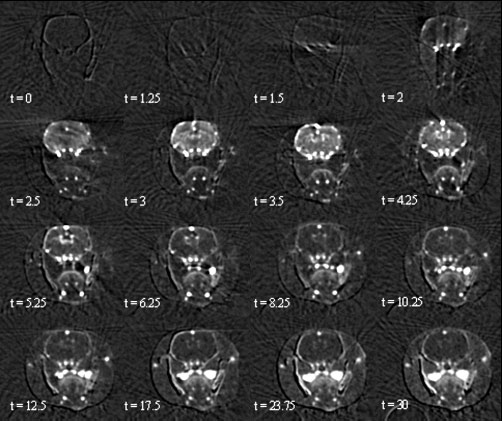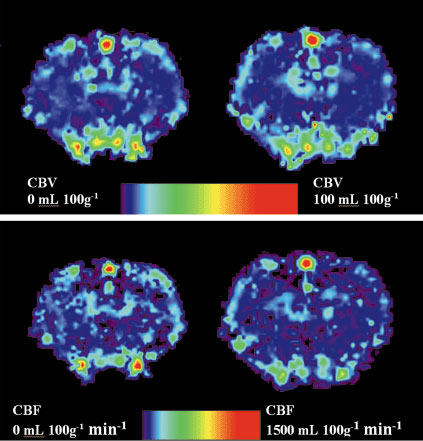- Home
- Users & Science
- Scientific Documentation
- ESRF Highlights
- ESRF Highlights 2002
- X-ray Imaging
- Absolute Cerebral Blood Volume (CBV) and Blood Flow (CBF) Measurements Based On Synchrotron Radiation Quantitative Computed Tomography
Absolute Cerebral Blood Volume (CBV) and Blood Flow (CBF) Measurements Based On Synchrotron Radiation Quantitative Computed Tomography
CBV and CBF are important perfusion parameters related to cerebral haemodynamic changes such as those observed in brain tumours, stroke or ischemia. Most of the medical imaging methods have been used to quantify these parameters in vivo and to build functional maps of the brain. All of these methods have major drawbacks for an acute tracer concentration quantification, which is the basis of perfusion assessment (poor spatial resolution for PET, non-linearity for MRI, beam hardening and scattering for CT scanners). Synchrotron Radiation Computed Tomography (SRCT) opens new fields by using monochromatic (avoiding beam hardening effects) and parallel X-ray beams allowing the sample to be placed far from the detector (thus avoiding scattering effects). This technique allows measuring absolute contrast agent concentrations with high accuracy and precision [1] with a good spatial resolution (0.35 mm for the ID17 germanium detector). A relative error on the measured concentrations less than 1% is found for the range 0.35 to 1 mg mL-1 of iodine, which corresponds to the usual concentrations measured in the brain tissue. A relative error less than 3% is found for the range 2 to 25 mg mL-1 of iodine, which corresponds to usual concentrations measured in the blood vessels. A noise equivalent to 55 µg mL-1 of iodine is observed in the SRCT measurements.
Absolute CBV or CBF measurements are based on the method employed in dynamic computed tomography [2]. It uses the time course changes in the iodine concentration after the infusion of a bolus of iodinated contrast agent in each voxel of the brain tissue in comparison of the same changes in an arterial input of the brain. In this model, the CBV, CBF and Mean Transit Time (MTT) calculations are theoretically derived from the non-diffusible tracer kinetic theories applied to dynamic CT bolus tracking methods, since the contrast agent remains intravascular.
 |
|
Fig. 97: Head axial time course of iodine concentration maps (mg mL-1) on a healthy rat obtained by SRCT, after a bolus infusion (only 16 images amongst 125 are displayed). Time (t) is expressed in s, the infusion starts at t = 0. Iodine enters the brain vasculature via the arterial inputs, passes through the brain microvasculature and is washed out by the intracerebral and extracerebral venous outputs. |
The experiments are performed on healthy rats. After the intravenous injection of a bolus of an iodinated contrast agent, Computed Tomography (CT) images are acquired every 2 seconds. The first image acquired before iodine infusion is subtracted from the others in order to get CT slices expressed in absolute iodine concentrations (Figure 97). Each pixel of the slice provides a curve representing the iodine time course in the corresponding brain voxel. These curves are fitted by gamma-variate functions in order to avoid the recirculation phenomenon. CBV and CBF maps (Figure 98a and b) are then computed by using these fits in the tracer kinetics models. A correction for partial volume effects in the chosen arterial input is necessary for a good quantification. Mean CBV and CBF values (n = 7) are found equal to 2.1 mL 100 g-1 ± 0.38 and 129 mL 100 g-1 min-1 ± 18 in the parietal cortex; 1.92 mL 100 g-1 ± 0.32 and 125 mL 100 g-1 min-1 ± 17 in the caudate putamen. These values are in good agreement with the reported ones in the literature.
 |
|
Fig. 98: a) Transverse CBV maps of two healthy rat brains. From purple to red the CBV increases from 0 to 100 mL 100 g-1. b) Transverse CBF maps of the same rat brains than the ones used for figure 98a. From purple to red the CBF increases from 0 mL 100 g-1 min-1 up to 1500 mL 100 g-1 min-1. Black pixels inside the brain slices indicate voxels where the CBF cannot be determined. |
This is the first in vivo assessment of the CBF and the CBV based on synchrotron radiation quantitative computed tomography. It is a new tool for studies in cerebral physiopathology hemodynamic changes, such as those observed in brain tumours or in cerebrovascular diseases. This method could be useful especially in the domain of novel attempts to treat brain tumours as far as these therapies induce changes in the brain perfusion. Various modalities of radiation therapy using synchrotron radiation are under active development in different synchrotron facilities, including the ESRF. The possibility of assessing brain perfusion reinforces the potential of these programmes.
References
[1] H. Elleaume, A.M. Charvet, S. Corde, F. Estève and J.F. Le Bas, Phys Med Biol 47, 3369-3385 (2002).
[2] L. Axel, Radiology 137, 679-686 (1980).
Principal Publication and Authors
J.-F. Adam (a), H. Elleaume (a), G. Le Duc (a, b), S. Corde (a), A.-M.Charvet (a), I. Troprès (a, b), J.-F. Le Bas (a), F. Estève (a), J Cereb Blood Flow and Metab., in press.
(a) Équipe d'Accueil RSRM, MRI Department, CHU Grenoble (France)
(b) ESRF



